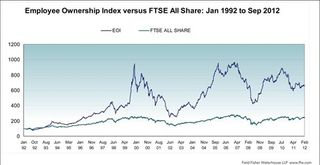Wouldn’t you love it if your employees thought and acted like partners in the business? If they brought the enterprise, energy and enthusiasm that ensured your success? Well that is effectively what employee engagement is and why you need it.
So, if you want your employees to be like that, to think and act as though they were partners, you need to treat them as partners. And the best way to do that is to make them co-owners of the business. And you don’t have to just take my word for it.
“Employee ownership can enable companies to tap an immense reservoir of energy, intelligence, and extra effort from people throughout the organisation. It can get everyone focusing on the same goals and working towards the same objectives. It can lead to a quantum leap in a company’s performance, not to mention in employee satisfaction." That statement is from the book, “Equity. Why employee ownership is good for business,” by Corey Rosen, John Case and Martin Staubus (©2005 Harvard Business School Press)
They claim that companies adopting employee ownership “saw between 4-5% higher productivity in the year they did so; the higher productivity level was maintained in subsequent years.” This is borne out by the Employee Owned Index which shows employee owned companies out-performing the FTSE All Share Index consistently over a 10 year period.
The graph, however, clearly indicates fluctuations which suggests that such superiority is not a given. In fact employee ownership is simply a start. As you would expect, if you don’t make a big deal of it, and also link it to some sort of participatory management scheme that encourages employees to work co-operatively and enthusiastically taking greater responsibility for peak performance – their own and others’ – it won’t make any difference. That, of course, is empowerment.
Unfortunately, even where ownership and empowerment (participatory management) are found, and do make a significant difference this is only a fraction of what it might be. This is because they mostly involve equity and that comes with inherent limitations. These include:–
- Cost to the employer and/or employee
- Affordability for lower-earning employees
- Availability in a non-publicly traded company
- Valuation in a non-public company
- Line of sight between ownership and individual contribution and reward.
By offering employee ownership without equity the Zealise model provides a solution to all these limitations. It also offers an integrated participatory management approach that will ensure ownership in more than name and create the empowerment so essential to its ultimate success. So if you would like engaged employees – people who think and act like partners – you need to explore how this would work for you. Even, perhaps especially, if you don’t equity shareholders to begin with.
Bay is the founder and director of Zealise, a company created to help larger small to large business organisations to properly value their people and thereby inspire them to optimise their self-worth and so engage them that they transform organisational performance and bottom-line results. Bay is also the author of several books, including “Lean Organisations Need FAT People” and “The 7 Deadly Toxins of Employee Engagement.”


In the words of Corey Rosen, the founder of the National Center for Employee Ownership, “giving employees a sense of ownership is like giving a hungry man a sense of lunch.” Or, in my own words, employee engagement without ownership is hollow. There are solutions to all the limitations of employee share ownership listed in your article.
Hi Nigel
Either description is fine with me! Thank you for taking the time to comment. I appreciate it and glad you also think that my proposition solves all the problems of share ownership.
Bay